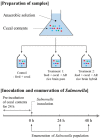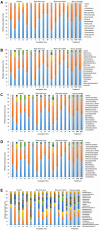The nasal microbiota in health and disease: variation within and between subjects
- PMID: 25784909
- PMCID: PMC5810306
- DOI: 10.3389/fmicb.2015.00134
The nasal microbiota in health and disease: variation within and between subjects
Abstract
Chronic rhinosinusitis (CRS) affects approximately 5% of the adult population in Western societies and severely reduces the patient's quality of life. The role of bacteria in the pathogenesis of this condition has not yet been established with certainty. However, recent reports of bacterial and fungal biofilms in CRS highlight a potential role for these microorganisms. In this study, 16S rRNA gene-targeted amplicon pyrosequencing and qPCR were used to determine the composition and abundance, respectively, of the sinus microbiota within 9 patients with CRS and 6 healthy individuals. Within-patient variability was also investigated by sampling from anterior nares, inferior turbinate, and middle meatus on each side of the sinuses. Our results indicate that more of the variation in bacterial composition can be explained by inter-personal differences, rather than sampling location or even disease status. In addition, bacterial community diversity was significantly lower in CRS samples compared to those from healthy subjects, whereas bacterial load was not associated with disease status. Although members of the genera Corynebacterium and Staphylococcus were prevalent in the majority of samples (including healthy subjects), the large amount of variation observed between individuals, particularly within the CRS cohort, suggests that an imbalance or dysbiosis in community structure could be the driving force behind the disease. Ultimately, understanding the causes of variation within the sinus microbiota may lead to more personalized treatment options for CRS.
Keywords: 16S rRNA gene; bacterial abundance; bacterial communities; bacterial diversity; chronic rhinosinusitis.
Figures






References
-
- Centers for Disease Control Prevention (2009). Multistate outbreaks of Salmonella infections associated with live poultry-United States, 2007. MMWR Morb. Mortal. Wkly. Rep. 58 25–29. - PubMed
-
- Donalson L. M., Kim W. K., Chalova V. I., Herrera P., Woodward C. L., McReynolds J. L., et al. (2007). In vitro anaerobic incubation of Salmonella enterica serotype Typhimurium and laying hen cecal bacteria in poultry feed substrates and a fructooligosaccharide prebiotic. Anaerobe 13 208–214. 10.1016/j.anaerobe.2007.05.001 - DOI - PubMed
-
- Donalson L. M., McReynolds J. L., Kim W. K., Chalova V. I., Woodward C. L., Kubena L. F., et al. (2008). The influence of a fructooligosaccharide prebiotic combined with alfalfa molt diets on the gastrointestinal tract fermentation, Salmonella Enteritidis infection, and intestinal shedding in laying hens. Poult. Sci. 87 1253–1262. 10.3382/ps.2007-00166 - DOI - PubMed
LinkOut - more resources
Full Text Sources
Other Literature Sources

